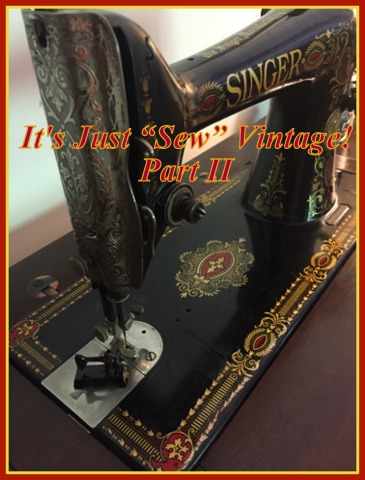
It was thrilling hearing how many people are vintage sewing machine enthusiasts! Thank you, everyone, who reached out! I’m excited to pass on more tips on vintage sewing machines, share how I’ve re-purposed vintage patterns, and announce the winner of the “September ‘Sew Cute’ Giveaway”!
A big CONGRATULATIONS to Laura M! Her name was randomly drawn from all the comments. Laura is my winner for the goodie box!

The perfect way to start a rainy weekend…
I loved ALL of the name ideas for my Singer-301A! Several suggested the name “Lucy”, which I’ve decided to go with since the name reminds me of someone special. Lucille “Lucy” Miller was our neighbor living across the street from me as a child in Bellaire, Texas. She was like family. After we moved when I was eighteen, she always kept in touch until she passed away at age 95 in 2002. I think of her often- she was a great friend and one of the most talented people I’ve ever known. Head of the alterations department of a major Houston department store, she made me many wonderful things when I was growing up, including the most beautiful Barbie doll clothes. “Lucy” it is!

Her name is “Lucy”.
Most vintage sewing machine enthusiasts agree that VSMs tend to multiply when we aren’t looking. Since my last blog, I’ve “adopted” a few more “babies”.

My cherished 1938 Scroll Plate Featherweight
As I write this, it’s currently my 24th wedding anniversary. My sweet husband surprised me with an early present: a 1938 Singer Scroll Plate Featherweight, like the one my grandmother would’ve sewn on! I named her “Carolyn”, after my beloved grandmother. She’s very sentimental, and has a place of honor in my sewing room.

We weren’t going to get more treadles, but my husband wanted this one, too. Meet “Cleopatra”, a Singer “Sphinx” model from 1910. I’m not done fixing her up. She and her table were really in need of TLC, but the Egyptian themed decals are spectacular!


I almost passed up this model, but I liked her look and the fact that she’s a Singer, though not as fancy as other models. The ¾ size Singer-192 “Spartan” was made at the same overseas plant where late-model Featherweights were made.

Slightly heavier and noisier than a Featherweight, the Spartan-192 is similar to a Singer-99, but more “sparse”. Another straight-stitch machine, this model, aside from the name at the top, has no fancy decals or lamp. This one belonged to the seller’s aunt and was well-loved. Super dusty, I was pleased how shiny she is after I cleaned her up! A sensible ‘50’s model, I dubbed her “Aunt Bea”. I was alarmed, however, when I opened the grease plate – it was filled with MEALWORMS! Always ask TONS of questions when buying a vintage machine. In this case, it worked out. “Aunt Bea” is still sound and sews, but there was a bit of an “ick” factor when I was servicing this one. NEVER plug in a very dirty machine before inspecting, or one that has any nicks or breaks in the wiring. It’s also a good idea not to use a VSM during a thunderstorm, and store unplugged when not using. Most VSMs don’t have an “off” switch except for the light, so when it’s plugged in, it’s “on”.
I wasn’t going to get anymore for awhile…then THIS happened. On my “wish” list was a VSM heavily decorated with floral decals, known as “Tiffany” or “Gingerbread” decals. My husband and I found this 1922 Singer-15. She was in pretty bad shape, but after five hours and a completely messed up manicure, cosmetically, she is stunning (she still needs work to be able to sew again). A good source for decal identification is here.
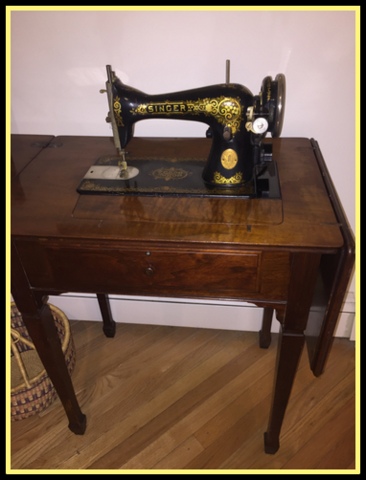
1922 Singer-15

Meet “Flora”. I love her Tiffany decals!

I found my bottle of Zymol on Amazon.
To shine up a vintage sewing machine, it’s recommended to use organic-based car wax “Zymol”, using clean, old soft cotton rags like cut up t-shirts to apply and then buff. A little goes a long way, and be careful around decals. If the clear coat has worn off, they could “silver”. To be safe, I avoid using on my decals, but it certainly shines up the paint!
If your Singer machine was “born” before 1970, visit http://www.mysingerstories.com . Enter your machine’s serial number in the right hand corner, and print out a free beautiful certificate with your name and the date your machine was made. LOVE!
Vintage patterns from the ’30’s, ’40’s and ’50’s have beautiful period art! When my friend Andrea bought a big lot of antique patterns, we wanted a way to re-purpose or display them (I’d love to sew one, but let’s face it, my one thigh wouldn’t fit those waistlines – women were so tiny back then)! We decided to make sewing-themed, decoupaged trays.
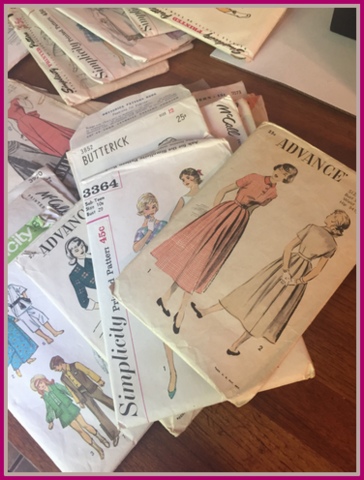
I had a cheap wooden tray from the 1990’s, and Andrea found a big painted one at Goodwill.

Before: Ugly, cheap and worn out – ready to re-purpose
After roughing up the surface of the trays with sandpaper (to help the patterns adhere) we spray painted them a matte black and let dry several days.
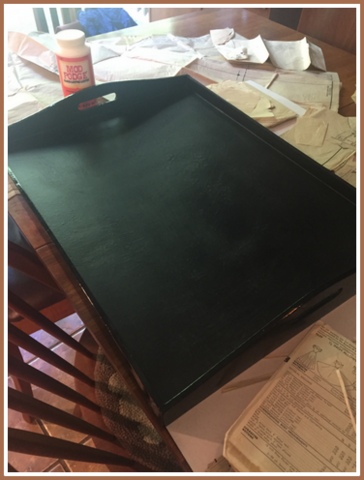
Once dry, decide on placement of the patterns on the tray. Use just the top of the pattern package by carefully cutting away the tabs and back, so you have a single flat page.

Apply Modge-Podge to the bottom of the tray, then carefully slide your pattern page on top where you want it.
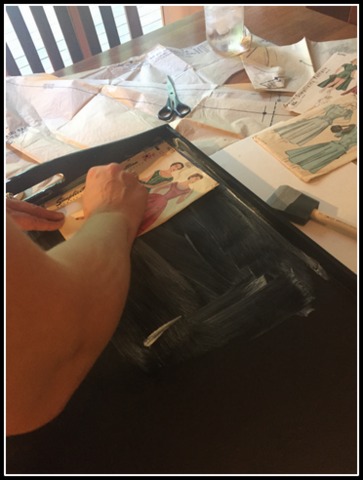
Once you have the patterns in the right spot, apply a top layer of Modge-Podge. Let dry, then apply again. Keep in mind that the paper’s very old, and probably wasn’t the best quality. You might get little rips or air bubbles. Carefully flatten out the pieces using a Modge-Podge roller or your fingers, always keeping the pieces moist with Modge-Podge. If the Modge-Podge gets dry when you are flattening or shifting the paper, you risk ripping the image. For air bubbles, use a straight pin to carefully “pop” the bubble, and use the pinpoint to insert Modge-Podge under the image where the air bubble occurred, then liberally apply more on top.

Apply several coats, letting dry between each one, alternating the coats’ direction from top to bottom and side to side. It won’t dry completely glass smooth, but will have a “textured” look.
The Modge-Podge, when wet, will obscure the colors, but once dry the pictures will “pop” again. I did five coats of Modge-Podge. Finally, let the whole thing dry completely (I waited a week) then spray a coat of clear lacquer varnish and let dry.
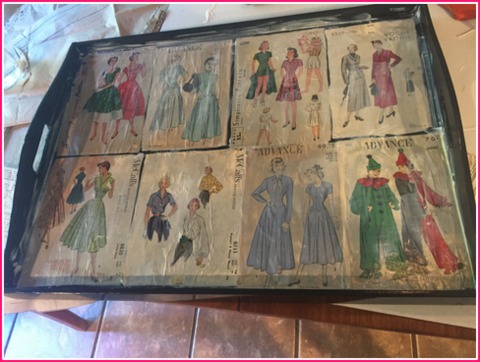
When wet, the colors will look muted, but wait…

…when dry, the colors “pop”
Cute anywhere, mine decorates my sewing room! (Re-purpose the tissue paper pattern pieces by stuffing them in purses and shoes to help keep their shape in your closet. Cleaner than newspaper and more chic than plain tissue, doing this will help your purses and shoes last longer. I also use tissue pattern pieces as shipping box stuffing and as gift bag tissue wrap).
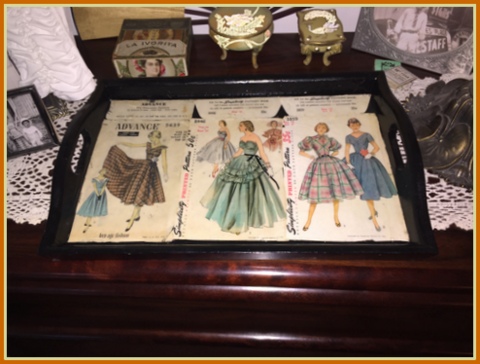
I decided to unclutter my sewing room and display my VSM’s, taking them all out of their cases. I rotate which one I use, depending on what project I’m sewing. I love ‘em all. I also “decked out” the treadle in the family room for Halloween!

Happy Halloween!
Honestly, I can’t promise I won’t add to my collection! It’s a bug, and I’ve been bitten, but there’s something so satisfying about taking something many would discard and restoring back to original glory.
Until Next Time…Farmgirl Hugs, Nicole





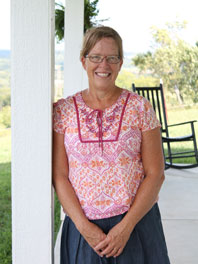
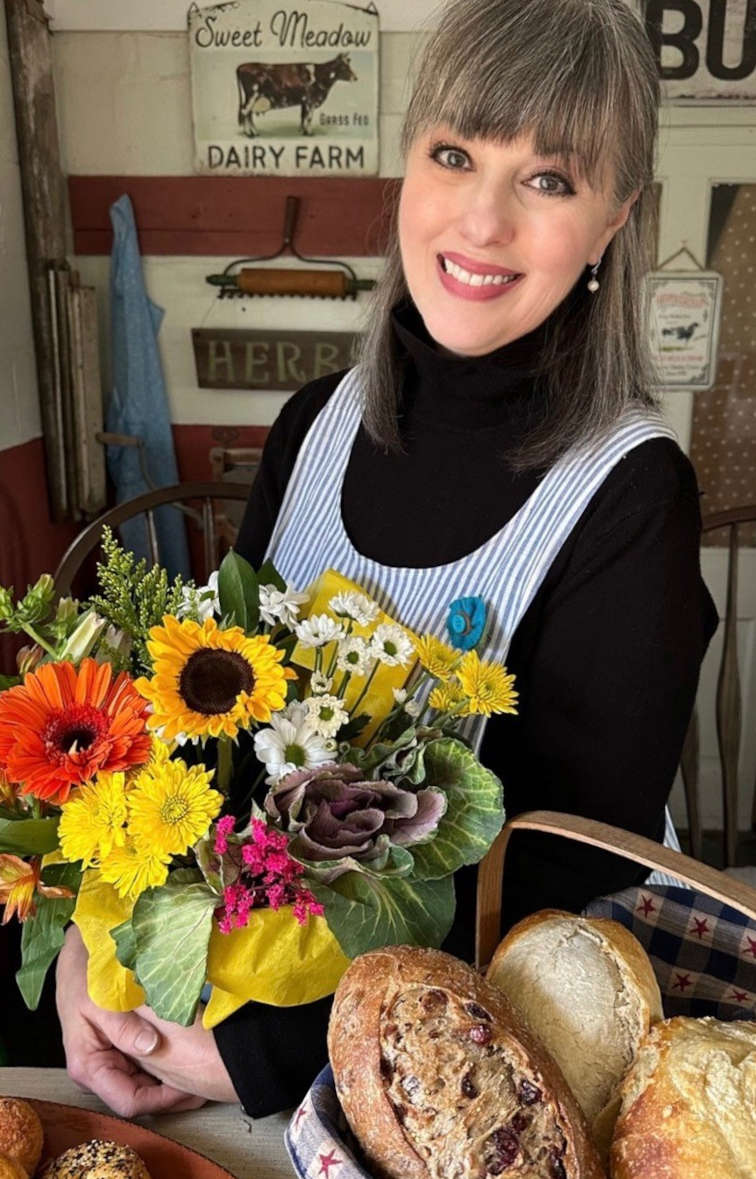


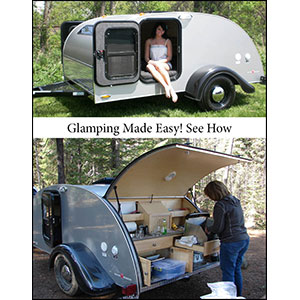

Love your new sewing machines and your Halloween decorations on display! What a great touch! I have a question for you. Have you stained or restored the Singer cabinet or is that it’s original condition? Would staining the cabinet lower its antique value? I also like how you repurposed vintage patterns. I want to try something like that!
Hi Krista! Great question. Years ago, I was in the fine furniture business with my husband, specializing in Scandinavian imports, so I learned quite a bit about wood. What I’ve found with most of the antique pieces I’ve found is that the wood is in need of moisture. It’s dry and pale. I use a product from Denmark that is sold here, called “Clean and Feed”. (Find it here: http://www.scancare.net/RETAIL_CATALOG.html). It has kept me from needing to refinish the wood, even when I thought I would need to. If the wood has old wax buildup, it helps with that, too. Unless the wood veneer is cracked, I like to leave it alone and just moisturize it. After wiping the dirt and crud and dust off with a nearly dry damp cloth, I use Clean and Feed a couple of times, letting dry between coats. The Scand-Oil that is carried on the same page is good, too. As for staining the cabinet lowering the value, that is what I have always followed, and have some serious antique connections in the way of family and friends. However, I think if a piece is really far gone, and you can make it look better or closer to its original condition, then go for it. In that case, it would make sense that the value would go up. The one you asked about I did not refinish, just restored with cleaning and using the Clean and Feed. Let me know if you make something with your patterns! Farmgirl Hugs, Nicole
Thank you so much, Nicole! I will pass this information on to my parents. They have an old singer they are looking to fix up, so when I shared your blog post with them they were thrilled!
Awesome! Let me know how it turns out. 🙂 Farmgirl Hugs, Nicole
It is an addiction. I have over 25 vintage machines. Love them all…..
I love what you did with the wooden tray and the vintage patterns.
Hi Sylvia, Thank you so much. Wow – 25! I love it! Farmgirl Hugs, Nicole
I love “old” machines too. I gave my grandmother’s treadle to sonshine4u so she can enjoy it as much as I have. I learned on a treadle and sewed lots of things on it. I also have my aunt’s toy singer from the 1020s and used to sew doll clothes on that. Thanks for loving and appreciating the past and sharing with us.
Hi Bonnie, Thanks for reading! I love that you appreciate and love your heirloom treasures! Farmgirl Hugs, Nicole
I love older machines, too. I stalled for a long time, but so wanted a Featherweight and was fortunate to find mine some 20 years ago in Abingdon, VA at their annual Highlands Festival which is held in August every year. It was in really good shape, but, of course, I did spend time shining it, using the lubricating tube contents and oil to make it really ready. There is no smell like that machine oil and lubrication once put in the machine and it starts working it’s way through the gears, etc. Mine is a 1950 Celebration model and it still pieces quilts just fine. There is something magical about putting needle to thread on these little beauties. Featherweights seem to go into hiding ever so often, but many can be found in Hillsborough, TN at the quilt shop there. Don’t hesitate. Treat yourself. I have the case for the machine and LOTS of feet, too. And, yes, the case does have its own odor. It’s OK.
So glad I did.
Hi Rebecca, Yes, the Featherweight is just the perfect little machine! There is a Highlands festival in Virginia? Oh my! How fun…roadtrip!! I have heard about the case odor some of the Featherweights have. It is usually with the older black cases, and comes from the glue, which at that time was animal-fat based. I have a green case that came with my white Featherweight, but it is one of the very last models produced, so it has no odor, except for a faint dusty, musty smell that went away after I aired it out. My black ’38 Featherweight did not come with a case, I suspect it might have been thrown out due to the odor (though I have heard there are ways to get rid of it). I’d never throw a case out no matter how stinky! I love that you piece quilts on yours. I want to do that, too. Thanks for commenting! Farmgirl Hugs, Nicole
I love the decorated sewing machine. We have a decorated sewing machine too. Thanks for sharing this post and photos.
Marilyn
Hi Marilyn, Thank you! Farmgirl Hugs, Nicole
I absolutely love old sewing machines and have a featherweight that I’m afraid to use. She’s so pretty! I’m also on the look-out for children’s sewing machines. They are all on display in my craft room. It’s so refreshing to know there are other women just like me!!
Hi Tracey! Thank you! A cute vintage children’s machine is the next on my wish list, as well as a “hand crank” machine. Why are you afraid to use your Featherweight? They are workhorses. I would use it if it is in working order. Farmgirl Hugs, Nicole
I was fortunate enough to find a delightful Betty Ross sewing machine at a garage sale and it works.
Hi Marjorie, Oh those are so sweet! I love them. Congrats on a great find! Farmgirl Hugs, Nicole
I love that you do this. I loved and used my vintage machine for quilting when I first learned to sew more than twenty years ago. Regrettably I no longer have that machine, it pains me to say. I just wanted to take a moment to express my enjoyment of your blog post.
Hi Gael, Thank you so much, I am so happy that you like the post. Means alot. I am so sorry you no longer have your machine. My mom regrets not having hers anymore, too. I wish she did as well. Thanks for stopping by the blog! Farmgirl Hugs, Nicole
What a fun blog. I have my great grandmother’s treadle with its Singer table. My father who passed on 12 years ago refinished the table and it’s beautiful. I love vintage machines and totally understand people’s interest in them.
Was wondering if you have any tips for a featherweight case. I purchased a featherweight about 2 years ago. It runs beautifully, however the case is covered with a white spotty film- ?mold? I purchased several brands of leather cleaner/wax like you would use on shoes. No effect whatsoever. Do you have any suggestions? Thanks.
Hi Joan! Thank you! I have a white Featherweight with a green and white case. The machine was mint, but the case came to me filthy and with a gross sportiness like you describe, except my spots were orangey. Similar to how I cleaned up some vintage luggage, I used care to not hurt the case. First I wiped the whole case down with an almost-dry, ever-so slightly damp cloth, being careful to wipe afterward with a completely dry cloth. Then I used a Mister Clean Eraser, ever so slightly damp (again, wrung out to almost dry). You will be amazed what you can get off of an old case with one of those. Do not “scrub” too hard, as you do not want to harm the material the case is made of, and work in a small area. I then wipe the case down with a dry, soft cloth like an old t-shirt. Also, make sure you do not buy the Mr. Clean Magic Eraser with the soap inside. Last thought, if it is a mold on the outside, have you tried a little vinegar on each spot? Let me know how you do. In any case, it’s what is on the inside that really counts. 😉 Farmgirl Hugs, Nicole
Hi Nicole,
I am starting to curb that collecting gene now! I have a 1911, and a 1921 treadle Singer 127 models. One has the Sphinx design that I also love so much. At the Animal Welfare League I lucked into the 1911 motorized Singer in it’s carry case. Such an elephant, and it works beautifully. I was told that the church women used it to sew roll-up sleeping bags for the homeless. Luckily we had a repair man in West Liberty, a town nearby, who repaired old machines for the Amish and Mennonite’s. He supplied the leather belt and re-wired my machine. I recently learned he retired when I needed a Centennial 1950 Singer cleaned up that I scouted out for my good friend in Kentucky. Luckily he helped train a woman who now carries on this good work. I once found a cream-white FW like yours with the green and white case in wonderful condition. Before I could use it our house burned down! Well, Mr. McCulla had a black one (with a mildew smelling case) and I bought that one. My heart was with the white one though. They all work so well that I won’t buy a modern one now. At thrift shops, I have been able to buy the attachments and have nearly all of them and a buttonholer. I’ll use vinegar first and then the Mr. Clean sponge to get the mildew off. Thanks for that tip. Keep up your wonderful blog. Ellen in Ohio
Ellen, Thank you for sharing! I am so sorry about your house burning down, and wish you find another white FW someday! I also heard that if your case is faded, you can use shoe polish to touch up spots, but I have not tried this myself yet. Farmgirl Hugs, Nicole
This was great fun!!! I am going to get online and see what my machines story is. Also going to get her shinny. God bless.
Hi Joan, Have fun! I love finding the stories of old machines. So special. Thanks for commenting! Farmgirl Hugs, Nicole
Hello Nicole,
Really love your blog and enjoy your stories so much. Thanks for all the hard work you put into your writing. Also, thank you for the link to download and print a certificate for older Singer sewing machines. I have a 1928 treadle given to me by a dear friend before she passed away. And of course she bears my friend’s name. My certificate is printed and waiting to be framed and hung above the machine. I love featherweights, too, and have put one on my Christmas list!
I also love your decoupaged trays of vintage patterns. Another idea is to frame the fronts of the envelopes in floating frames. The painted wall or wallpaper will be the background when hung, or you can cut and mount any background you wish behind the envelope picture. We have recently moved, but I will hang these in my sewing room when we get unpacked and organized.
Thanks again for a wonderful blog!
Hi Keleen, Thank you so much! It means a lot that you enjoy my blog. 🙂 I love your idea for framing, too. I have two patterns that are sentimental that I have wanted to frame but wasn’t sure how. I will now be looking for floating frames! I hope Santa brings you a Featherweight! Farmgirl Hugs, Nicole
Nicole, these are the floating frames I got. It seems they are presently on sale 🙂
http://www.joann.com/8×10-woof-float-frame-white/12531448.html
Hi Keleen, Those are great! I have bookmarked the site to see if they come back in stock. They’d be perfect. Thanks for sharing! Farmgirl Hugs, Nicole
Pingback: Out With the Old, In With the …Old!? | Farmgirl Bloggers